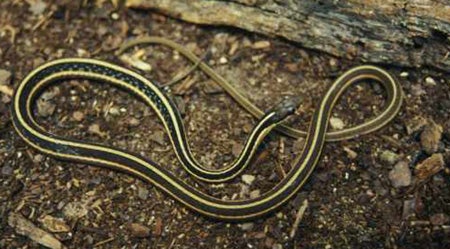SCIENTIFIC NAME:
Thamnophis sauritus sauritus
STATUS:
Fairly common statewide, but not as frequently encountered as in the past. Low Conservation Concern.
DESCRIPTION:
The eastern ribbon snake is a small nonvenomous snake that gets its name from its very thin body. At maturity adults can range from 16-28 inches long. Its color scheme consists of a brown back and white belly with two light yellow lateral stripes running down the side and one light yellow vertebral stripe down the center of the back. The lateral stripes are separated from the belly by a golden, brown or yellowish orange middorsal stripe. The Ribbon Snake has a sequence of 19 keeled scales, which are rough to the touch with a ridge in the center of each scale. Lip scales are uniformly yellowish or white with no markings between them. The tail of the Ribbon snake accounts for about one third of total body length.
Ribbon snakes resemble the closely related eastern garter snake Thamnophis sirtalis sirtalis and may be easily confused with it. The ribbon snake generally has a more slender profile and will have a shorter tail than the garter snake. On the ribbon snake, the lateral stripes that extend down the sides are located on the third and fourth scale row. Garter snakes side stripes are located on the second and third scale rows. The vertebral stripe is always present on the ribbon snake, but may be absent on the garter snake.
DISTRIBUTION:
The eastern ribbon snake can typically be found in the eastern United States and southeastern Canada. It ranges from the southern region of New England throughout southern Ohio and Indiana to the Mississippi River. The Ribbon snake can be found throughout the rest of the southeast except for southern Georgia and peninsular Florida.
HABITAT AND FEEDING HABITS:
Eastern ribbon snakes prefer moist environments such as wetlands, ponds, stream edges, rivers, and other sources of flowing and standing water. They primarily look for areas that are well vegetated with cattails, grasses, shrubs, and other plant life that will provide them with adequate cover for feeding and escaping from any nearby predators. They are most active in the spring when rain fall is abundant. However, they can remain comfortable in unfavorable dry summers by utilizing burrows of common muskrat (Ondatra zibithica), round-tailed muskrat (Neofiber alleni), crayfish (Cambaridae spp.) and other species becoming dormant until conditions improve. The ribbon snake’s preferred food is frogs, but they will forage on other species of amphibians, insects, and fish. Throughout most of the year they are mainly diurnal in their feeding pattern, meaning they are most active in the early morning and late evening. However, during the spring when frogs begin to breed, they will become very active during night hours. Ribbon snakes will constantly prowl for food, and have been known to swim with their mouths open until they come into contact with fish or other prey.
LIFE HISTORY:
Ribbon snakes will mate in the spring between April and May after emerging from hibernation. After reproduction the male inserts a copulatory plug into the female to prevent other males from mating with her. Females are viviparous, which means they will give birth to live young. The young are usually born in late summer between July and October. Brood sizes can range from 3 to 26, but 10 to 12 is most common. Following birth, parental care is not given. The population of the eastern ribbon snake is considered to be high throughout our region.
REFERENCES:
Behler, L. John and King F. Wayne. The Audubon Society Field Guide to North American Reptiles and Amphibians. New York: Alfred A. Knopf, 1992.
Earnst H. Carl, Ernst M. Evelyn. Snakes of the United States and Canada. Smithsonian Institution Press: April 17, 2003.
Ohio Department of Natural Resources
The Center of Reptile and Amphibian Conservation and Management
University of Georgia, Savannah River Ecology Laboratory
University of Massachusetts Amherst
Virginia Department of Game and Inland Fish
AUTHOR:
Barry Baird, Wildlife Biologist, Alabama Division of Wildlife and Freshwater Fisheries.






